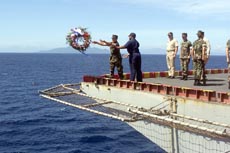 |
 |
|
||
|
|
CA-44
News
|
Sloop
News
|
|
|
|
|
| Battle of Guadalcanal Commemorated | |||
|
Tarawa group commemorates WWII Battle of Guadalcanal Battle described as turning point in Pacific region during war Task
Force 16 receives citation |
Hundreds of crewmembers and Marines from the 13th Marine Expeditionary Unit (MEU) (Special Operations Capable) gathered on the flight deck during the ceremony on the San Diego-based Tarawa. Addressing the formation with Guadalcanal in the background, the Commodore of the Tarawa ARG, Capt. A.D. Wall, challenged the Sailors and Marines present to imagine a time more than 50 years ago. "Step back in time, with Sailors and Marines who may be your fathers or grandfathers," said Wall. "Imagine the early years of World War II when the war was not going so well." Wall highlighted the importance of the battle, which has often been described as a turning point in the Pacific theater. Before the Battle of Guadalcanal, which began in the late summer of 1942, the Americans had suffered a string of defeats that enabled the Japanese to expand further west. In an attempt to slow down the Japanese expansion throughout the South Pacific, Chief of Naval Operations Adm. Ernest King ordered a hastily assembled task force to make an amphibious assault on the little-known island of Guadalcanal to take a Japanese airbase. During the next six months, isolated Marines fought desperately to defend the airfield they had taken, while at least 12 major naval engagements -- many of them surface battles at night -- raged in the waterways near the islands. "The individual battles that made up the six months of Guadalcanal are too numerous to mention here," said Col. C.J. Gunther, 13th MEU(SOC) commanding officer, "but they include such names as Tulagi, the Solomon Islands, Coffin Corner, Ironbottom Sound and the |
Tokyo Express. The action was so constant that every night saw some kind of fight or gun battle." Guadalcanal was significant for several reasons. Over the course of numerous sea battles, including night surface encounters, the United States painfully learned the lessons of conducting naval operations after dark. The battle also struck at Japanese confidence and established the will and determination of the U.S. Navy and Marine Corps. In a campaign of attrition, American forces lost 615 planes and 25 warships but destroyed more than 680 aircraft and 24 warships. The myth of Japanese invincibility had been dealt a devastating blow. "These gritty champions of freedom had turned the tide in the Pacific," said Wall. After the speeches, Wall accompanied Gunther and Tarawa's commanding officer, Capt. Garry Hall to the flight deck, as a Sailor and a Marine dropped the wreath into the same waters that claimed the burning hulks of the heavy cruisers USS Vincennes, USS Astoria and USS Quincy almost 58 years ago. "This was a good history lesson," said Yeoman Seaman Vevalyn Smith, the Tarawa Sailor who dropped the ceremonial wreath. "I didnít know anything about the battle until we had the ceremony." The Tarawa ARG made the stop near Guadalcanal during its six-month deployment to the Western Pacific and Indian Ocean. Since arriving in the Central Pacific, the Tarawa ARG has steamed along a route that could be easily labeled as a World War II Memorial Trail. After leaving Pearl Harbor, Hawaii, (the site of the USS Arizona Memorial and USS Missouri -- the respective symbolic beginning and end of the war in the Pacific) the ARG stopped at the Tarawa Atoll. On the island of Betio, the primary site of the fighting during the Battle of Tarawa, local islanders greeted a contingent of approximately 100 Sailors and Marines who arrived for a memorial ceremony. The stop at Guadalcanal marks the third major World War II site the ARG has visited in less than three weeks. "This is a lot different than just reading about it in books or hearing it told in stories," said Sgt. Pablo Cortez, a member of the Amphibious Squadron Five staff and the Marine who dropped the wreath. "When you see the island, the reality of what happened there hits home." Navy journalist William Polson, USS Tarawa Public Affairs |
|
